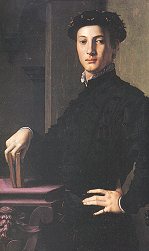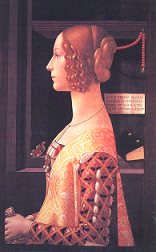| Shaking off the dejection into
which this miserable spectacle had plunged him, he slew with innumerable
dagger thrusts the sleepers before they had time to waken. And after
he had ordered that their dead bodies should be dragged from the room
and left exposed, he made a statement of his reasons for this butchery,
and departed with his familiars to his city of Venosa. This tragedy
took place on the night of the 16th October, 1590. The bodies of the
wretched lovers remained exposed all the following morning in the midst
of the hall, and all the city flocked to see the pitiful sight.
The lady's wounds were all in the belly, and
more particularly in those parts which she ought to have kept honest;
and the Duke was wounded even more grievously. Too beautiful, too
alike, too unfortunate were this unhappy couple. At the hour of vespers
the bodies were removed for burial amidst the lamentation of the entire
city. Such was the end of impure desires.
|

 Growing
up in the 1560s young Carlo Gesualdo was unencumbered with the usual expectations
of the eldest male heir to the throne. That was until his older brother Luigi
did him a dirty trick by dying. The result was the expectation that Carlo would
now assume the mantle of the eldest male heir and accept responsibility for
governing, and of course marriage to guarantee that Gesualdo name would live
in perpetuity. The bride chosen for him was his first cousin Donna Maria d’Avalos,
a "surprising beauty of 21 years who had already given ample proof of her
fecundity." In other words she was a "passionate woman" whose
first husband had died from excessive "conjugal carnality." She then
gave up her second spouse in order to marry Carlo.
Growing
up in the 1560s young Carlo Gesualdo was unencumbered with the usual expectations
of the eldest male heir to the throne. That was until his older brother Luigi
did him a dirty trick by dying. The result was the expectation that Carlo would
now assume the mantle of the eldest male heir and accept responsibility for
governing, and of course marriage to guarantee that Gesualdo name would live
in perpetuity. The bride chosen for him was his first cousin Donna Maria d’Avalos,
a "surprising beauty of 21 years who had already given ample proof of her
fecundity." In other words she was a "passionate woman" whose
first husband had died from excessive "conjugal carnality." She then
gave up her second spouse in order to marry Carlo.